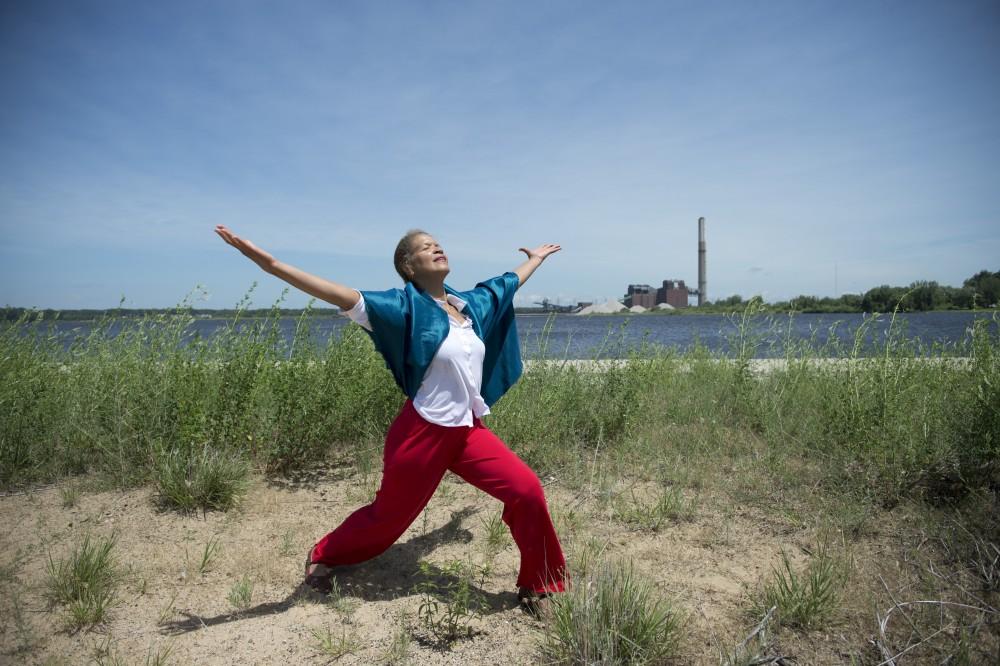Inviting new winds

GVL / Courtesy – University Communications Robin Wilson
Aug 16, 2014
Students, faculty and alumni from the University of Michigan and Grand Valley State University have come together for a performance that includes dance, poetry and music centered on Muskegon’s metamorphosis from a manufacturing community to a community powered by renewable energy.
“Into the Wind” will be performed on Aug. 22 and 23 at 7 p.m. at Michigan’s Alternative and Renewable Energy Center (MAREC) in Muskegon. Admission is free, but seating is limited for the indoor portion of the performance. Audience members are advised to make a phone reservation. Transportation is available for participants who might find the outdoor walk difficult.
Jessica Fogel, a University of Michigan dance professor, was inspired by the work of Sara Adlerstein, associate research scientist and visual artist for U-M School of Natural Resources and Environment. Adlerstein participated in a Great Lakes offshore wind park project and was able to obtain funding to produce a video about aesthetic perception of the structures.
Adlerstein invited Fogel to collaborate on the video, but the project didn’t come to fruition. However, the idea of doing a dance performance about wind energy stuck with Fogel.
To further her research on wind energy, and because of her interest in MAREC as a setting for the performance, Fogel attended a lecture on offshore floating wind turbines held at the center. Fogel began to work with Arnold Boezaart, the director of MAREC, who Fogel said has been a tremendous help with the project.
Boezaart said a key reason this came together was due to a signing ceremony that happened three years ago, when the presidents of each university at the time – Thomas J. Haas and Mary Sue Coleman – stood up at the board of regions and entered into an agreement that stated the two universities would look for opportunities to collaborate. The director said when he met Fogel he thought that this opportunity would fit the vision that the two presidents had.
“In working on the performance and studying the site, I became intrigued with the layered history of the MAREC location,” Fogel said. “I learned that MAREC had been the former site of the Continental Motors factory, the manufacturing heart of Muskegon, and that when the factory closed it left a large hole in the community.”
Fogel incorporates this piece of history into the performance. In a section of the dance, interviews she conducted with former factory workers can be heard. As an outsider to the community, she said she is struck by the resilient spirit of Muskegon and the many initiatives in the city pointing toward a rebound.
The U-M dance professor is a site dance choreographer, which is a choreographer who creates performances for alternative spaces. In this case, the performance moves from inside of MAREC – the state designated “SmartZone” that focuses on developing renewable energy technology – to outdoors, where across the bay the 600-foot tower of the B.C. Cobb coal plant serves as a backdrop. Fogel said the probable closing of the coal plant in 2016 presents new challenges and opportunities for the community.
“There is something special about an audience becoming active participants and taking a literal journey with the performers,” Fogel said. “Traveling outside to the site allows the audience to literally set foot upon the site’s history and imagine its potential for transformation.”
The first dance is entitled “H.A.W.T.” an acronym for “horizontal axis wind turbine.” The segment is choreographed by Shawn Bible, GVSU dance professor and U-M alumnus. It will also include music that employs the sounds of wind turbines, composed by GVSU music professor Nate Bliton.
The second dance, entitled “Circlings,” is choreographed by Fogel. Part of the sound used in the dance is from wind data gathered by a buoy launched by MAREC to study the potential for offshore wind development in Lake Michigan. The data was transformed into sound by sonification consultant Robert Alexander.
“The dance contains materials that evoke more abstract notions of wind – as the very breath within us, and as an invisible force that can propel bodies through space. The dancers’ breath forms part of the musical score composed by David Biedenbender,” Fogel said.
Keith Taylor’s poem “Circle in the Wind” concludes the dance, which speaks eloquently to our need to harness wind to “heal the world we damaged,” Fogel added.
Taylor, an English professor at U-M, said he hopes the audience has a sense of what a dance performance can be when the creators expand the definition, and that they connect the dance with the wind and the power the wind can give us.
Aside from being visually and aurally rich, Fogel said the performance will offer the audience a vision of the ways the arts can provide environmental stewardship and can engage with issues and ideas within a community.
Adlerstein agreed, adding, “Problems in society are becoming increasingly complex and require creative solutions. Educational institutions need to include the arts in all fields of study so students become creative professionals rather than narrow minded specialists.”

























